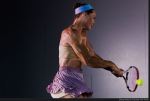Having returned from the espnW retreat at Torrey Pines in La Jolla, CA I have been thinking about many things. If you don’t know, ESPN is expanding its brand to include espnW “to serve, inform and inspire the female athlete and fan.” The digital launch will occur March 2011 and the target audience of espnW is women 18+. The retreat brought together key stakeholders in women’s sport, and it was quite a group! I felt very fortunate to be a part of the event, as it was a first-class endeavor from start to finish. You can see pictures on the espnW Facebook page. Laura Gentile, Vice President of espnW, has put together a dedicated team. Her opening night remarks can be found here, that will tell you a bit more about espnW since there is quite a bit of misinformation swirling out in cyberspace.

Billie Jean King at opening keynote @ espnW Retreat
Legend Billie Jean King spoke both at the opening ceremonies and during a breakfast conversation with Julie Foudy and Sage Steele. She was clearly fired-up about the endless potential of espnW. During her remarks she said, “its OK to want something…don’t settle for the crumbs, want the whole cake!” Well, I want the whole cake when it comes to espnW! At one of the sessions we were asked, “What would espnW.com look like to you?” I’ve been thinking about this ever since.
I think the answers would vary because not all women are the same, but for me here is what the whole cake looks like. I want to see only information, opinions, stats, blogs, videos, commentary, and expertise about women’s sport and female athletes–Period. I also want most of the information and content on the site to be developed, written and delivered by females. There should be at least (well really I want more!) as many females and females in positions of power on espnW, as I see males and male athletes on ESPN.
I’m also clear about what I don’t want to see on espnW: dumbed-down sport, a version of Self Magazine + Sport, male sports, or male athletes. If I want information about men’s sport I already know where I can go to get that information. If I want information about nutrition, motherhood, fitness, and well-being, I already know where I can go to get that information. Give me aggregated, high quality, legitimate, serious information ABOUT WOMEN’S SPORT AND FEMALE ATHLETES, I don’t know where to find this information (unless I visit 20 different websites).
espnW is uniquely positioned to give female fans and athletes, and post Title IX females in general, what we’ve been so desperate for–a legitimate place to read about women’s sports and female athletes. According to researchers, female athletes only get 1.6% of all sports coverage on major networks, a figure that has declined from 6.3% since 2004. Data over the last 25 years shows female athletes only get 6-8% of coverage for sport print media. Research on the coverage of female athletes and social media lags behind, but based on the data it runs the gamut from unfiltered sexism to empowerment.
espnW has done consumer insight and market analysis research and their blue chip take home is that females are a different breed of sport fans. Women are busy, multidimensional, and primarily are still responsible for domestic and childcare duties. Many women have less time for sport consumption than their male counterparts, and when they do, the consumption probably looks different. I don’t disagree with this assessment but the few studies which have sampled female fans find their motive to attend sporting events is nearly identical to male sport fans—they like sports! espnW kept stressing females and female sport fans specifically want to be (inter)connected, and experience a community more than do male fans. A colleague of mine once said, “Male sport fans attend to be seen, while female sport fans go to see others.” This wisdom may translate to social media, but the challenge of how that looks digitally is now in the hands of espnW, because only the ESPN brand is big enough and has sufficient resources to actually do this right. That is a BIG responsibility because it will meet resistance, from both males and females (as Megan Hueter of Women Talk Sports pointed out in her blog).
Given the record numbers of females participating in sport, it hasn’t translated into record numbers of females as sport fans (although the data show that trend is on the rise). I disagree with the espnW promo literature that states “once an athlete, always a fan” because if that were the case we would have a lot more female sport fans of both men’s and women’s sports.
I would love to see research on the pathway(s) for females to become sport fans. How do we get female sport fans to consume the sports they once played? That pathway and socialization process is clearly in place for males. I ask a similar question when I ask, “How do we get former female athletes to coach the sports they once played?” The answer is complicated and one I’m still trying to figure out, but I think some of the strategies to increase the number of female coaches translate–ask and invite female to be fans, promote early involvement/hook ’em early, reduce the time commitment it takes to consume sport, and make it easy. I heard echoes of these themes in how the espnW digital presence will be constructed. I also think there would many MORE female fans if we could see legitimate coverage of women’s sport and female athletes….(enter espnW).
However, I fear than until we change the current structure of gender roles in the family and workplace, it will continue to be difficult for some (perhaps the majority of) women to be the kind of sport fans, consumers, coaches, and administrators they desire to be.
I am wishing espnW and their brand team the best, a lot is riding on its success.
photo from espnW Facebook page.
 As a scholar who examines gender in the context of sport I’m always interested in the ways the media arbitrarily construct gender–meaning the images we see in the media tell “us” what it means to be a girl or boy, and what is appropriately feminine and masculine.
As a scholar who examines gender in the context of sport I’m always interested in the ways the media arbitrarily construct gender–meaning the images we see in the media tell “us” what it means to be a girl or boy, and what is appropriately feminine and masculine.









